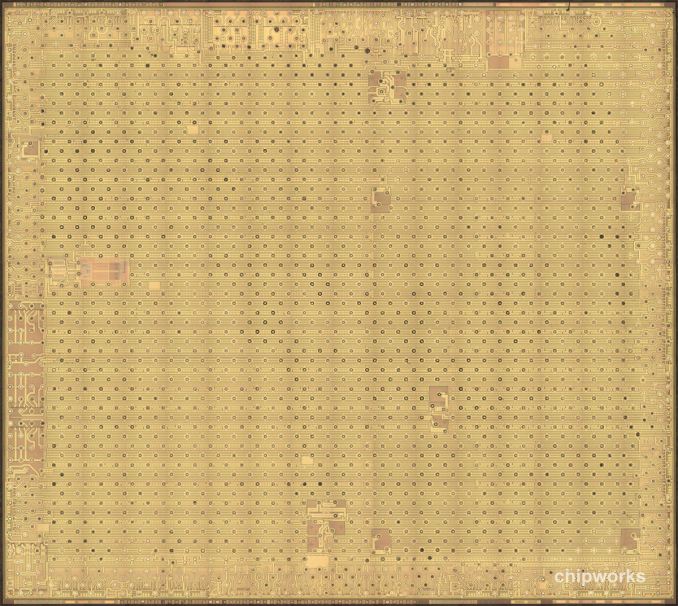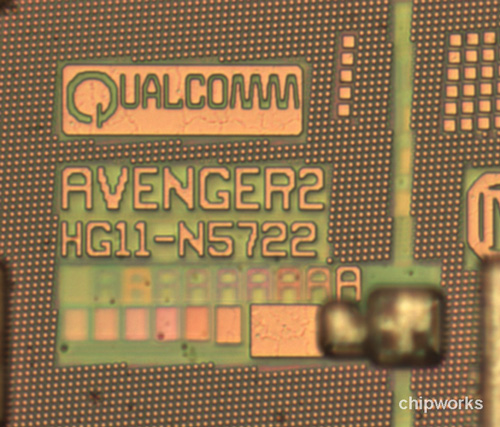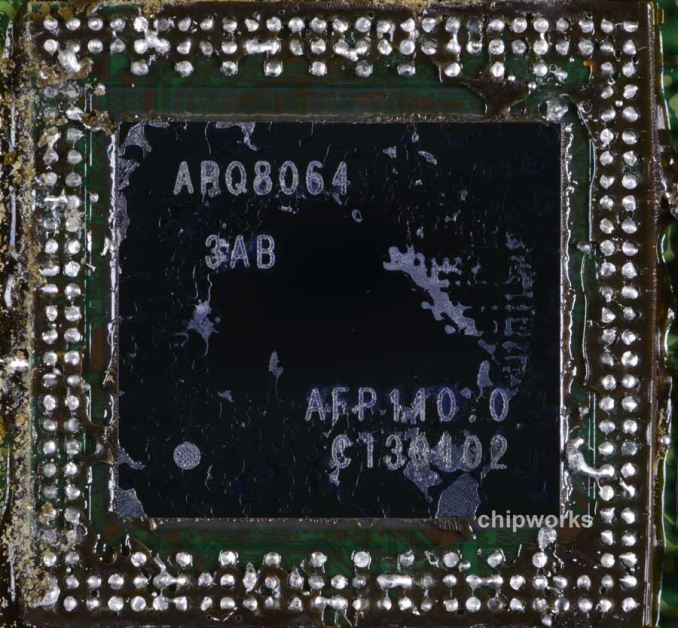Samsung Galaxy S 4 Review - Part 1
by Brian Klug on April 24, 2013 12:01 AM ESTGalaxy S 4 - Powered by a Better Snapdragon 600 (APQ8064AB)?
At a high level, Samsung's Galaxy S 4 integrates Qualcomm's Snapdragon 600 SoC. From what Qualcomm told us about Snapdragon 600, we're dealing with four Krait 300 cores and an Adreno 320 GPU. The Krait 300 cores themselves are supposed to improve performance per clock over the original Krait CPU (Krait 200) through a handful of low level microarchitectural tweaks that we've gone through here. The Krait 300 design also allegedly improves the ability to run at higher frequencies without resorting to higher voltages. This isn't the first time we've talked about Snapdragon 600, but since then a few things have come to light.

Snapdragon 600 from HTC One - Chipworks
For starters, Chipworks got their hands on a Snapdragon 600 SoC (from an HTC One) and delayered the SoC. In its investigation, Chipworks discovered that Snapdragon 600 had the exact same die area as the previous generation Snapdragon S4 Pro (APQ8064). Also, although you'd expect APQ8064T markings on the chip itself, the part carried the same APQ8064 label as previous S4 Pro designs.

Avenger 2 Markings on Snapdragon 600 die from HTC One - Chipworks
Chipworks did note however that there were some subtle differences between a standard APQ8064 and the Snapdragon 600 SoC from the HTC One. The Snapdragon 600 from the One is labeled with an Avenger2 codename rather than Avenger, the latter was apparently present on prior APQ8064 designs. Chipworks also noticed differences in the topmost metal layer, although it's not clear whether or not they stopped there or found no differences in lower layers.
All of this points to a much more subtle set of physical differences between APQ8064 and the earliest Snapdragon 600s. Metal layer changes are often used to fix bugs in silicon without requiring a complete respin which can be costly and create additional delays. It's entirely possible that Krait 300 was actually just a bug fixed Krait 200, which would explain the identical die size and slight differences elsewhere.
That brings us to the Galaxy S 4. It's immediately apparent that something is different here because Samsung is shipping the Snapdragon 600 at a higher frequency than any other OEM. The Krait 300 cores in SGS4 can run at up to 1.9GHz vs. 1.7GHz for everyone else. Curiously enough, 1.9GHz is the max frequency that Qualcomm mentioned when it first announced Snapdragon 600.
Samsung is obviously a very large customer, so at first glance we assumed it could simply demand a better bin of Snapdragon 600 than its lower volume competitors. Looking a bit deeper however, we see that the Galaxy S 4 uses something different entirely.
APQ8064 from a Snapdragon 600 based HTC One - Chipworks
Digging through the Galaxy S 4 kernel source we see references to an APQ8064AB part. As a recap, APQ8064 was the first quad-core Krait 200 SoC with no integrated modem, more commonly referred to as Snapdragon S4 Pro. APQ8064T was supposed to be its higher clocked/Krait 300 based successor that ended up with the marketing name Snapdragon 600. APQ8064AB however is, at this point, unique to the Galaxy S 4 but still carries the Snapdragon 600 marketing name.
If we had to guess, we might be looking at an actual respin of the APQ8064 silicon in APQ8064AB. Assuming Qualcomm isn't playing any funny games here, APQ8064AB may simply be a respin capable of hitting higher frequencies. We'll have to keep a close eye on this going forward, but it's clear to me that the Galaxy S 4 is shipping with something different than everyone else who has a Snapdragon 600 at this point.











335 Comments
View All Comments
sigmatau - Thursday, April 25, 2013 - link
Oh and I own a Nokia 900 and am looking to go back to Android. My phone works great. The email is perfect, never a crash, and the UI is smooth and flood. What is lacking is software. I just bought a Camaro and can't even use the OnStar app for it. The battery could be better and the camera isn't the best. For work, though, it is perfect. Email and IE is tops for my job. Not sure why portal websites still don't work as well on Android. I, also don't understand why the screen (OLED made by Samsung) is unreadable in sunlight.Hrel - Wednesday, April 24, 2013 - link
Wow, what's with all the hate on Sprint? Even camping in Wisconsin I have service on Sprint. Who cares if the phone is made of metal or plastic or cow dung? You should ALWAYS be putting your smartphone in a case, ALWAYS! So I say use the cheapest durable material possible. Since it's ALWAYS in a case, it's fine. If you aren't putting your 600 dollar+ phone in a case NO, you are WRONG, it ALWAYS goes in a case, ALWAYS!MilwaukeeMike - Wednesday, April 24, 2013 - link
Alright, I had to jump in here... I'm a sprint user in Wisconsin and their network is terrible. They are the only major carrier who's speed tests must be measured in kpbs instead of mbps to avoid the heavy use of decimals. He put a caveat on the review because a slow network makes the phone work longer and hurts battery life and because Sprint's network is so much slower, you'll see much better results from other networks. He made the right choice to leave out a 3G browsing graph because it wouldn't be an accurate showing of the phone's battery life.... especially since his other phones are on other (better) networks.You do realize some people care about materials... if you don't, fine use a case. but if you do care, then the metal phones are nicer. Apple's had success with their metal phone too you've probably noticed.
Hrel - Wednesday, April 24, 2013 - link
Apple had success because it's Apple. People who buy Apple buy Apple, they could release a phone powered by human blood and people would buy it. If you live near MIlwaukee or Green Bay then I'm not sure what you're talking about. If you live podunk then yeah, you need Verizon. But Verizon is 110/month. Virgin Mobile (Sprint) is 35/month. I'll take a slower network over 900/year.dolo4delf - Wednesday, April 24, 2013 - link
I have an Ipod Touch...love it....would not buy an Iphone though...kyuu - Wednesday, April 24, 2013 - link
No, you are wrong. Do what you like with your own phone, but I'm not putting mine in a case -- adding extra weight and thickness, ruining the in-hand feel, or covering up the exterior -- because you say so.And no, I don't own an iPhone.
sigmatau - Thursday, April 25, 2013 - link
Go shove your case! You are wrong! If your phone needs a case, than it is a sorry POS. The only case I've had for a phone was a terrible Samsung phone. Not for a blackberry, not for an iphone, not for my Nokia 900. So you are wrong. Put your laptop in a case when you use it.gnx - Wednesday, April 24, 2013 - link
Glad to hear the camera is an upgrade. Looks like Sammy was primarily concerned about comparison with the Iphone5, focused on pixels, aperture, software enhancements (including aggressive night mode), etc. I have to admit, since I take photos oft in well-lit situations, outdoors and indoors, and don't take photos with friends in low-light bars often, this is what I'm looking for as a daily driver. Also, less noise in background colors is an important plus for me, since I blow up parts, and crop out others for the optimal photo to share.Hopefully Klug will update his review when he gets a hand on the international Exynos Octa version? I'm going for that one, even if I have to lose LTE, since it's more useful for travel abroad, and hopefully will have better CPU/GPU performance and maybe battery too. I don't think there's been a actual customer product with ARM's Big.Little architecture (Exynos Octa being a variant), so I'm looking forward to an analysis by Anandtech on that.
Battery is my third concern, but when you can buy a spare battery and chargers that charge both the phone and the battery at the same time, it becomes a mute problem.
AMOLED is always something of a hate-love relationship. It's oversaturated and power-hogger in browsing mode (cause of the white background), but I have to admit, unlike a laptop or desktop screen, in the relatively cramped phone, it does make the screen pop-out more. Especially with the minimal bezel on this SGS4! I remember each time I'm in carrier stores, the AMOLED screens really catch one's eye when side by side with a LCD screen, even though under further use, the LCD seems to have better clarity, even it it seems subdued. But what I really want to know is if the AMOLED tech used on this SGS4 has matured enough that we don't need to worry about gradual burn-in, which was a real problem in older AMOLED screens.
Touchwiz is still too chaotic for me, but at least I can always install a custom launcher. Just wish they provided an optional color theme for settings, etc, but that's probably asking for too much. At least, if this sells well, we'll have ample support from XDA developers.
Plastic is the bummer here. Gees, is it really impossible to build removable batteries and sd cards without resorting to plastic? My originally HTC Nexus One had a removable backcover. Surely, Samsung can do something close too? (No?) Or has Apple cornered so much of the aluminum supply, that it's prohibitively expensive and detrimental to timely large scale production? (as some Sammy sources imply?) Can't help wondering, with the competition from the HTC One, the next Note III due this fall will have a metal or some other upgraded case.
In anycase, further reviews on international SGS4 models with different parts, and updated reviews for the HTC One with US carriers and updated software would be appreciated!!
Thanks, Anandtech!!
BestPal - Wednesday, April 24, 2013 - link
Brian, you guys always do the best reviews, thanks!Y'all also do the most technically comprehensive reviews too, which is great for us gear heads :)
In that vain, and since you have the Sprint variant, I would like to ask a bit of a technically curious question I have about the Sprint variant...
Sprint is now finally going back to using removable SIMs on their GSM-capable devices, which is awesome for folks who travel overseas. Even better, Sprint is fairly liberal about unlocking their devices, albeit with having the OEM modify the device such that it won't do GSM inside the US on US bands, which is a long-standing Sprint thing but is absolutely fine. The main thing is that it allows using the device with a foreign SIM outside the US. However, on this device Sprint appears to have had Samsung do something strange, which is even though the device passed the FCC with UMTS 850 in it, Sprint appears to have requested Samsung to disable it, EVEN FOR overseas usage, leaving it with only UMTS 1900 and 2100. For those of us who frequently travel to South America (and a bunch of other places in the world too), crippling that band for overseas use is very problematic. Any idea why Sprint did that? Since in Sprint's case that band won't be useable in the US anyway. Anyway, I can think of no good reason to do this.
antef - Wednesday, April 24, 2013 - link
Samsung doesn't know how to do UI and they prove that with every phone or tablet they put out. TouchWiz is like Windows XP and IE6 with a million extra toolbars installed. The hardware menu key is awful and if they stopped and thought about it for a few moments they would realize why it's bad for new users, the platform, and those switching between tablets and phones. As the owner of two Samsung Nexus devices, I think they're hardware is great, but they can't get it together with usability and UI.